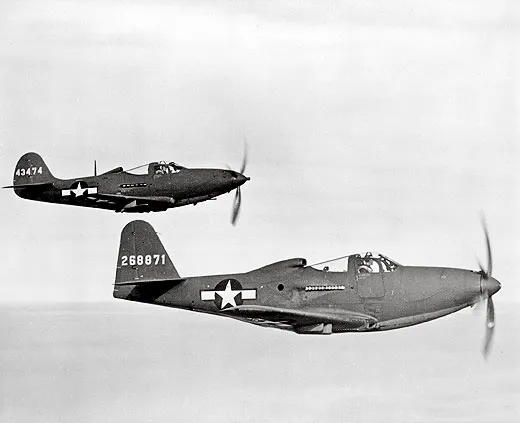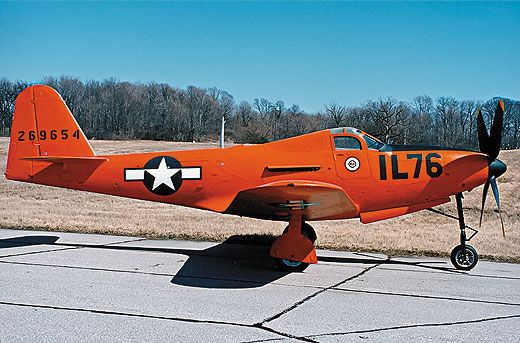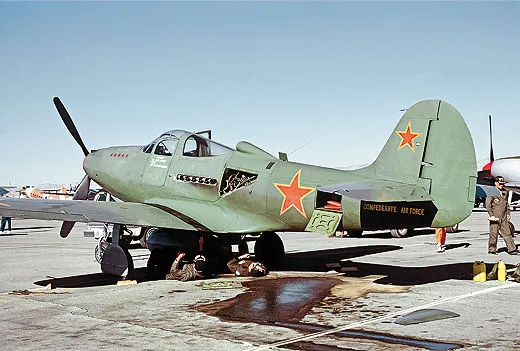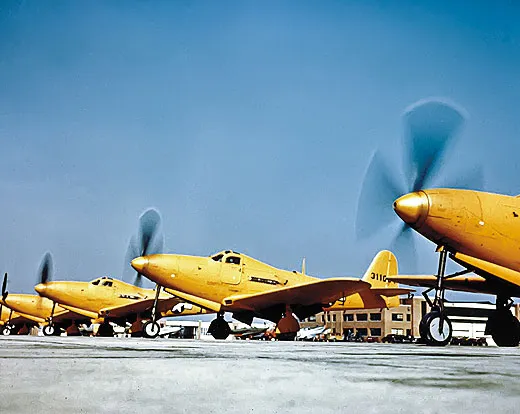Just Shoot Me
Late in World War II, the Bell P-63 became an aerial gunner’s easiest target
/https://tf-cmsv2-smithsonianmag-media.s3.amazonaws.com/filer/Just_Shoot_Me_FLASH.jpg)
The problem was deadly serious: In 1943, U.S. bombers in Europe were being shot down at an alarming rate. But one attempted solution provides a smile some 67 years later: an unloved American fighter stripped of its guns, painted clown-orange, and sheathed with armor that made it fly like an anvil, so that aerial gunnery students in B-17s and B-24s could shoot at it. The Bell Aircraft RP-63 Kingcobra, affectionately called the Flying Pinball Machine because of a red light on its nose that flashed when a student’s bullets hit the airplane, made its greatest contribution to the war effort as a punching bag on the home front. Its pilots enjoyed the work, for the most part. Horace Ashenfelter was a newly commissioned pilot flying the Pinball in 1945 at Tyndall Army Air Field near Panama City, Florida (and later became an Olympic steeplechase champion). Says Ashenfelter, “We were playing war games, like kids!”
By the spring of 1943, the U.S. Eighth Air Force, a unit tasked with strategic air assault against Germany, had swelled to 500 heavy bombers. Losses had swelled too. In a June raid on Kiel and Bremen, Germany, 26 bombers were shot down, 22 of them flown by inexperienced crews. In July, German fighters downed 128 U.S. bombers. U.S. gunners, meanwhile, claimed to have shot down 545 German fighters that month, a number later adjusted to 40 when planners realized that multiple guns on the same targets were producing huge errors.
On August 17, the Americans sent 146 bombers to pound the Messerschmitt factory at Regensburg, while another 230 hit the ball bearing factories at Schweinfurt. German fighters savaged the bombers, claiming 60 in a day. Into the fall of 1943, the carnage continued: September 6, Stuttgart, 45 bombers lost; October 8, Bremen, 30 lost and 26 badly damaged; October 9, above several targets in Germany and Poland, 26 lost; October 10, Muenster, 30 lost; and over Schweinfurt’s ball bearing plants again on October 14, now called Black Thursday, 60 bombers down. The result: U.S. commanders halted deep penetrations into Germany until the arrival of the P-51 Mustang escort, with its extended range.
Long before the Eighth Air Force took these losses, Cameron Fairchild, an Army Air Forces major, wanted to improve the results of the guys in the gun turrets. A trainer at Harlingen Army Air Field in Texas in the spring of 1942, Fairchild intended to improve on such practice techniques as firing shotguns at clay pigeons, shooting .30- and .50-caliber machine guns on the ground at targets on wheels, simulating air combat on a movie screen, and shooting at target banners towed by B-17s, B-34s, or AT-6s. Fairchild wondered if a bullet that splintered harmlessly on impact could be developed to fire at real pursuit airplanes.
It took the better part of a year for researchers at Duke University and the University of Michigan, as well as engineers at the Bakelite Corporation, an early maker of plastics, to come up with a plastic-metal casing for the bullet. By late 1943, the team delivered a frangible—breakable—bullet that would not jam a .30-caliber machine gun, would fly like a real bullet, and would shatter on impact. Powdered lead manufactured by DuPont gave the bullets the proper weight and density.
Some in the Army called Fairchild a “lesser Billy Mitchell” for his willingness to risk rebuke in the zealous pursuit of his ideas. Promoting the frangible bullet, he defied the usual path of Army ordnance development by first working with academics Paul Gross and Marcus Hobbs at Duke. The Army Ordnance Department then argued that a bullet made of frangible material would have different ballistics from a real one, wouldn’t fire properly, and could be safely fired only at a target airplane that had been heavily armored. The National Defense Research Committee approved the idea, but with limited funding and urgency, which slowed its progress.
In Fairchild’s favor, reports through 1943 and 1944 showed that gunners in Europe needed better training. Fairchild turned his attention to a target airplane. In the first half of 1944, a flirtation with the twin-engine, combat-proven Douglas A-20 gave way to Bell’s single-engine P-63, which the Army deemed more like a Messerschmitt Bf 109. Like its P-39 ancestor, the P-63 had been ignored by the Army in favor of the P-51 and the P-47 Thunderbolt. And like the P-39, the P-63 was exported through the Lend-Lease Act to the Soviet Union and France.
The Pinball was given modified cockpit glass that was more than an inch thick, and its wings and forward surfaces were heavily armored with a special aluminum alloy. Beneath the armor, sensors registered hits, which were displayed on a counter in the cockpit. In the nose, the 37-mm cannon was replaced by a light that flashed red with every hit.
Beginning in early 1945 at air bases in Florida, Texas, Arizona, and Nevada, Pinball pilots began to take off and rendezvous with B-17s and B-24s. From the skies over the Florida Everglades, the Gulf of Mexico, and huge swaths of western desert, countless shell casings and spent bullets began to fall. In each bomber’s waist were 12 student gunners with 2,000 rounds each, taking turns as the RP-63 swooped down from above in an attack pattern.
“We’d fly curves of pursuit, like fighters did in battle,” says Henry “Hank” Rodrique, then a 19-year-old second lieutenant flying Pinballs at Harlingen, Texas. “Sometimes when I’d break off, they’d still shoot.”
Robert Corson, a crew chief at Yuma Army Airfield in Arizona, says, “The Pinballs would come in with holes in the empennage, because the gunners would freeze on the trigger and keep on firing when the Pinballs pulled up at the end of a run, and the rudder and horizontal stabilizers were vulnerable. We’d just patch the holes with small squares of cloth and glue them on, and go on our way.”
One gunner, Harry J. Byer, recalls, “The RP-63s were making high side passes, and about the last couple of hundred yards the instructors would make us stop firing. Then the guy would break down under the ship, come up on the other side, go up on the perch, and make another pass. When they’d finish a pass, they’d call the ship and say, ‘You got six hits, or ten, or three.’ ”
“We would normally fly two or three missions a day,” says Ashenfelter. “The missions would last about an hour and a half. The RPs would hold gas for about two hours’ worth, but by the time you got up there and did your thing with each airplane you had to attack, you’d be out of gas.”
The Pinball pilots were a mixed lot. Some were newly minted 19- or 20-year-old second lieutenants on their first assignments. Others were veterans of combat missions with fighter groups in England and Italy. After flying frontline fighters, adjusting to the RP-63 was not a problem for veterans, but deliberately letting themselves be shot at took some getting used to. “We’d get pilots with combat experience in Europe,” says Corson, “and they’d come to our base after a month or two of R&R. The first time around in an RP-63, the first mission, they were definitely twitchy. They’d been shot at, after all, and then going up and doing it on purpose was something they didn’t really like. But they’d all come down after that first mission with big grins on their faces.”
John Aranyos had flown 82 combat missions in the P-47 and been shot at plenty of times by Germans, but wasn’t sure about being fired on by Americans. “I’ll tell you what,” he says, “I was a little apprehensive. I got to my altitude and made my first pass at the bomber, a B-17. He was at 9,000 feet and I was several thousand feet higher. And I thought to myself that I was deliberately setting myself up as a perfect target for some eagle-eyed kid aspiring to be a top-notch gunner at my expense. I felt I was the world’s greatest idiot.
“As I made the first pass, I was expecting to feel the impact of the frangible bullets—and there was no impact! I couldn’t believe it. I thought they were dry firing at me or something. And the recorder showed I had been hit 14 times. That is when I started being able to feel confident that the airplane was going to give me a good ride.”
Though the RP-63’s Allison V-1710-177 liquid-cooled engine generated up to 1,800 horsepower, the armor made the aircraft challenging to fly. Still, Ashenfelter liked the extra weight. “It was not as maneuverable as the regular P-63, but it was smoother,” he says. “On the downside, you could get a little bit of a high-speed stall if you maneuvered it too abruptly, and then you had a real problem.”
Barrie Davis, flying Pinballs at Las Vegas after a 70-mission tour in Italy in the P-47 and P-51, found that out the hard way. “I made the mistake of trying a loop one day,” he says. “I dived to pick up airspeed, and I went up and over the top in good shape. But coming out of the loop, every time I’d put a little back-step pressure on the thing, I’d hit a high-speed stall. So it was just a question of which was going to happen first: Was I going to stall into the ground, or was I going to fly that machine out of the loop? Well, I made it out of the other side, but I was below the mountains.”
According to Merlyn Franck, who flew Pinballs out of Laredo, Texas, “The whole secret was to keep your airspeed up and a little power on at touchdown. One of our pilots neglected this advice and allowed his RP-63 to get too slow on final approach. He dropped it in so hard it drove both main gear struts up through the wings.”
The RP-63’s real Achilles’ heel involved wing root ducts that fed air to the engine’s cooling system. When a bullet found the duct, its fragments would puncture parts of the system. As the engine overheated, the pilot had to choose a bailout or a deadstick landing. The latter happened plenty of times on the dry lakes of Nevada. After taking a round in the air duct, Captain Ingvar Jacobsen found a lake bed before his engine quit. On another mission, the pilot of a bomber Jacobsen was working with was having engine trouble. When Jacobsen flew closer to inspect, the waist gunner opened up on him. At such a short range, the frangible bullets were as deadly as real bullets, and they shot out his engine. Jacobsen bailed out.
There were variations in the performances of the RP-63s, especially in the hit-counting system. Vibrations from the flight of the airplane itself could set off phantom hits. On other occasions, the counters failed to work. “Back on the ground,” says Davis, “we’d take a grease pencil and go over the whole plane and mark all the new hits.” The ones from previous missions had been circled; the new ones appeared as dust spots.
Through most of 1945, the Pinball program gave gunnery students their only realistic practice at aerial combat. In all, some 300 P-63s were converted into Pinballs, but the war’s end made them obsolete. A few continued to train B-29 gunners after the Japanese surrender, but by the end of 1947, all the Air Force’s RP-63s had been mothballed. When centralized gunnery control was developed for the B-29 and introduced in the spring of 1944, automated shooting took over. In the first version of the B-52, a gunner was located in the tail, but in later versions, he was moved to the cockpit, where he operated the guns remotely. In the decades since, Pinballs were replaced by target drones. In fighters, heat-seeking missiles replaced machine guns, and some bombing missions are now flown by unmanned vehicles directed by armchair pilots thousands of miles away.
In his book Operation Pinball, Pinball pilot Ivan Hickman recounted, “Most of the pilots I knew felt that the [P]inball program, despite its shortcomings and inherent dangers, was the training device of the future.” Those pilots weren’t totally wrong. But the future they spoke of turned out to be one measured in months. And, as Horace Ashenfelter noted, “It was fun.”
James Dunaway got into the magazine business at age nine, selling door to door in New York City. He is now the editor of American Track & Field. This is his first story for Air & Space.



